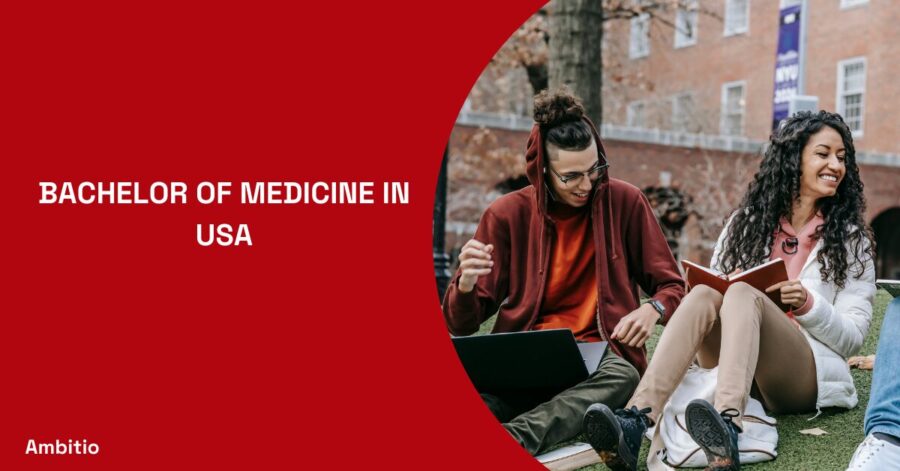14 December 2024
6 minutes read
Bachelor of Medicine in the USA: Charting Your Course for 2024

Embarking on a journey to study medicine is a decision that shapes not only your career but also your contribution to the well-being of society. The United States, renowned for its quality education and cutting-edge research facilities, continues to be a prime destination for medical aspirants from across the globe.
As we look towards 2024, this comprehensive guide is tailored to help you navigate through the intricate pathways to earning a Bachelor of Medicine in the USA.
The Pre-Medical Foundation: Undergraduate Studies in Health Science
Before diving into medical school in the United States, prospective doctors must first complete an undergraduate program. This is typically a Bachelor of Science degree with a focus on Health Science or a pre-med track designed to cover all the prerequisites for medical college admission.
Crafting a Competitive Pre-Med Profile
For those eyeing a medical degree, the undergraduate years are crucial. They must be carefully planned to ensure a competitive edge when it comes time to apply to medical schools.
Students are advised to engage in relevant coursework in biology, chemistry, physics, and mathematics. However, medical colleges also value a well-rounded education, so courses in the humanities and social sciences are encouraged to develop critical thinking and communication skills.
Beyond academics, undergraduates must gain clinical experience, which can involve volunteering at local hospitals, shadowing physicians, or participating in medical research projects. These experiences provide an essential glimpse into the practical aspects of medicine and can significantly strengthen your medical college application.
The Financial Aspect of Undergraduate Studies
Understanding the financial commitment involved in a pre-medical program is as important as the academic preparation. Tuition fees for undergraduate programs in the USA can vary widely, with private universities typically costing more than public ones.
However, there are numerous financial aid options available, including scholarships, grants, and work-study programs. It’s advisable to begin exploring these options early to ensure a well-planned budget for your pre-medical studies.
The Medical College Admission Test (MCAT): A Crucial Milestone
The MCAT is a standardized examination that assesses your problem-solving, critical thinking, and knowledge of natural, behavioral, and social science concepts and principles prerequisite to the study of medicine. A good MCAT score is a vital component of your medical school application.
Preparing for the MCAT
Preparation for the MCAT should begin well in advance of the test date. Many students invest in study guides, join preparation courses, or form study groups.
The examination covers a wide range of topics, and thus, a comprehensive study plan is essential. It’s also beneficial to take practice exams under timed conditions to get accustomed to the pressure of the testing environment.
Understanding the MCAT Scoring System
The MCAT score is a significant factor in medical school admissions. The test is scored in each of the four sections on a scale from 118 to 132, with a median score of 125 per section. The total score ranges from 472 to 528, with a median of 500. Achieving a score above the median is often considered competitive for most medical schools.
Navigating Tuition Fees and Scholarships for Medical School
The financial aspect of pursuing a medical education in the USA can be one of the most daunting parts of the journey. With the cost of medical school being a significant factor for many students, understanding the nuances of tuition fees, scholarships, and financial aid is essential.
Understanding the Tuition Fees for Medical School
Medical school tuition fees in the USA vary widely depending on whether the institution is public or private, the state in which it’s located, and the financial health of the institution itself.
For the academic year 2024, students can expect to see tuition fees ranging from $25,000 to $60,000 per year for public schools and significantly higher for private schools.
However, these figures only represent a portion of the total cost. Additional expenses such as laboratory fees, books, equipment, health insurance, and living expenses can add up to a considerable amount.
It is vital for prospective students to research the cost of attending their chosen medical schools thoroughly. Most institutions provide a breakdown of the total cost of attendance on their websites, including both direct educational costs and estimated living expenses.
Financial Aid: A Lifeline for Medical Students
Financial aid plays a critical role in helping students manage the costs of medical education. In the USA, financial aid can come in the form of federal loans, which often offer competitive interest rates and flexible repayment terms. Students may also be eligible for various institutional loans and work-study programs that allow them to work part-time while studying.
The application process for financial aid usually begins with the Free Application for Federal Student Aid (FAFSA), which assesses the student’s financial need and eligibility for federal aid. It’s important for students to submit their FAFSA as early as possible, as many aid programs operate on a first-come, first-served basis.
Scholarships: Minimizing the Debt Burden
Scholarships are another valuable source of funding for medical students. Unlike loans, scholarships do not need to be repaid, making them highly sought after.
Scholarships can be merit-based, need-based, or focused on specific criteria such as research interests, community service, or underrepresented backgrounds in medicine.
Several organizations offer scholarships to medical students, including the American Medical Association (AMA), the Association of American Medical Colleges (AAMC), and various specialty societies. Additionally, some states have their own scholarship programs aimed at encouraging students to practice in underserved areas after graduation.
Furthermore, individual medical schools often have scholarship funds available to their students. These scholarships can be based on academic excellence, leadership potential, or financial need. Prospective students should contact the financial aid offices of the medical schools they are interested in to learn about available scholarships.
Loan Forgiveness Programs: An Incentive to Serve
Loan forgiveness programs can serve as a significant incentive for medical school graduates to work in underserved areas or in specialties where there is a high need for practitioners.
Programs such as the National Health Service Corps (NHSC) offer loan repayment assistance to physicians who commit to working for a certain number of years in designated high-need communities.
Additionally, some states run their own loan forgiveness programs to attract healthcare professionals to work in rural or underserved urban areas. The terms and benefits of these programs can vary, so it’s important for students to research the specifics and application requirements well in advance.
Military and Public Service Options
For students interested in a career in the armed forces, the Health Professions Scholarship Program (HPSP) offers a full tuition scholarship for medical school in exchange for service as a commissioned medical department officer upon graduation.
Similarly, the Public Service Loan Forgiveness (PSLF) program forgives the remaining balance on direct loans after the borrower has made 120 qualifying monthly payments while working full-time for a qualifying employer, such as a government or non-profit organization.
The Application Process: Getting into Medical College
Gaining admission to a medical college in the USA is highly competitive and requires careful planning and execution of your application.
Crafting an Outstanding Application
A strong application to medical school includes solid MCAT scores, a high GPA, and a well-rounded undergraduate experience. Letters of recommendation are also crucial, as they provide medical schools with insight into your academic capabilities and personal character. Crafting a personal statement that reflects your passion for medicine and your future aspirations is equally important.
The Importance of Research and Extracurriculars
Medical colleges look for candidates who have demonstrated a commitment to the field of medicine through research and extracurricular activities. Participation in medical research projects can showcase your scientific curiosity and dedication to the advancement of healthcare. Leadership roles in relevant extracurricular activities, such as health-focused clubs or community service organizations, can also bolster your application.
Post-Graduation: Residency and Beyond
After graduating from medical school, the journey to becoming a licensed physician continues with residency, where graduates receive specialized training in their chosen field.
The Residency Match Process
The residency match process is a unique and complex system where graduates are ‘matched’ to residency programs based on their preferences and the preferences of the programs. It’s a competitive process, and students often apply to numerous programs to increase their chances of a successful match.
Career Prospects After Residency
Upon completing residency, doctors are eligible to become board-certified in their specialty. Career prospects for physicians in the USA are excellent, with high demand in both urban and rural areas. Physicians can choose to work in hospitals, private practice, academia, or even venture into healthcare administration or policy.
The Cultural and Professional Rewards of Studying Medicine in the USA
Studying medicine in the USA offers more than just a top-tier education. It provides a multicultural environment that enriches the professional and personal development of international students.
The Multicultural Advantage
The USA’s diverse patient population allows medical students to gain experience treating a wide range of conditions across different cultures and communities. This exposure is invaluable in developing the cultural competence necessary to become an effective healthcare provider in any part of the world.
Networking and Professional Growth
The connections and professional networks that students build during their time in medical school are pivotal for their future careers. The USA’s medical community is vast and offers numerous opportunities for mentorship, collaboration, and continued learning.
In conclusion, pursuing a Bachelor of Medicine in the USA in 2024 is a challenging yet rewarding journey. With thorough preparation, a clear understanding of the financial commitments, and a strong application, students can embark on a path that leads to a distinguished career in medicine.
The opportunities for growth, learning, and making a difference in the lives of others make the journey to becoming a physician in the USA an invaluable experience.
FAQs
What is the equivalent of a Bachelor of Medicine in the USA?
The USA offers a Bachelor of Science in Health Science or similar as a pre-medical degree, followed by an MD or DO degree.
How much does it cost to study medicine in the USA?
Tuition fees vary widely between universities and can be offset by scholarships and financial aid packages.
Are there any entrance exams for medical colleges in the USA?
Yes, the MCAT is a standardized test required for admission to most medical colleges in the USA.
Can international students practice medicine in the USA after graduation?
Yes, but they must pass the USMLE and fulfill all the necessary licensing requirements.

You can study at top universities worldwide!
Get expert tips and tricks to get into top universities with a free expert session.
Book Your Free 30-Minute Session Now! Book a call now




























